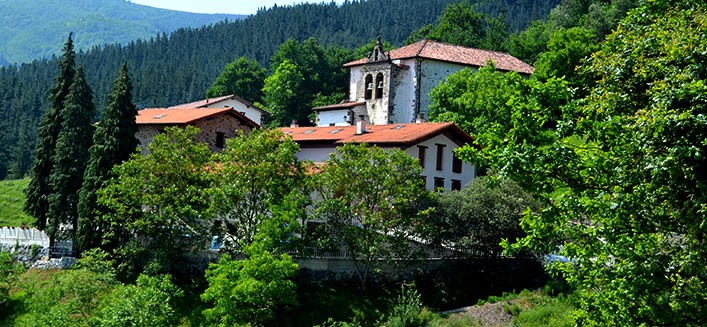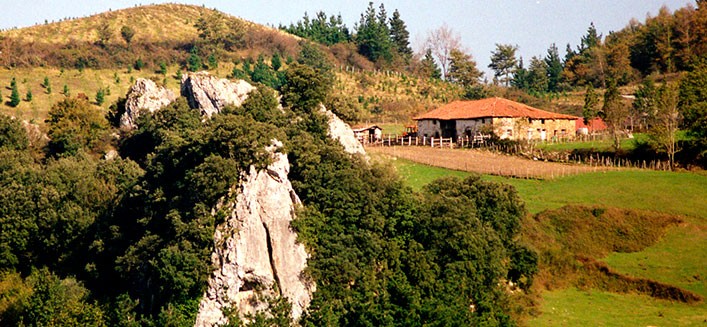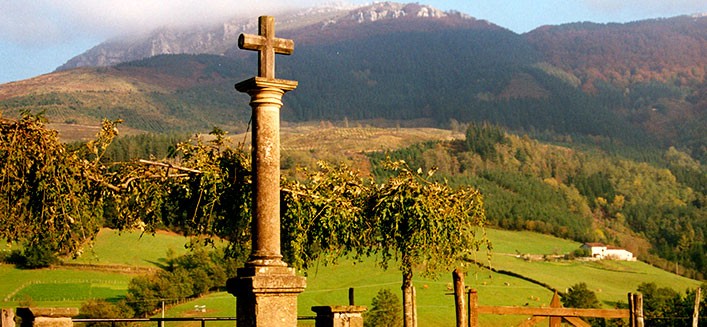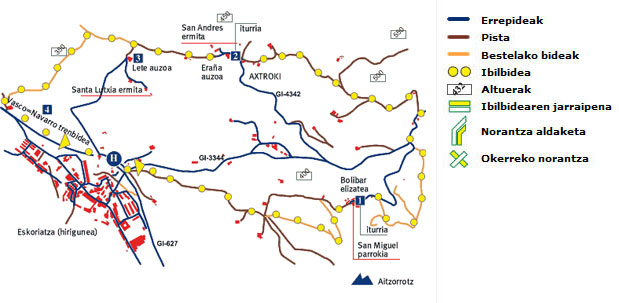This route goes through the ancient parish of Bolibar, giving you the opportunity to get to know its rural surroundings and enjoy its attractive woods and historic sites.
- Eskoriatza. After crossing the bridge of the bypass that goes from Eskoriatz to Bolibar, continue along the cement path on the right. Immediately you see some steps on the right, these take you to the old reservoir. After a short walk you go through an oak grove that has grown naturally.
- Agiriano Farmhouse. Going along a small trail you link up again with the cement path. On arriving at Agiriano Farmhouse instead of turning left, continue upwards along the dirt path until you reach a large holm oak. If you continue climbing this path you come to Aitzorrotz. In front of the holm oak, bear left and after passing a wooden fence continue along the path until the next crossing. At this point, taking the path to your left , descend until you reach Bolibar cemetery.
- Ancient parish of Bolibar. Following the road you pass alongside the parish church of San Miguel and a few metres ahead you go right along the dirt path that starts from the fountain. At the first crossing take the left path and 300 metres further on there is a wooden fence and the river, continue until the next crossing. At the next crossing after descending the left path, and passing alongside Bolibar river, you come to the road. A bit further ahead you turn right and then left to continue along the cement path.
- Axtroki. If you continue along the road that starts at the second crossing after the pine grove you will see an old oak tree and a little further on the crags of Axtroki. Back on the concrete path you come to a fountain next to the shrine of San Andres, in the hamlet of Eraña and later the junction of Lete.
- Hamlet of Lete. Continue along the path. Turning right at the next crossing is the path that leads to the ancient parish of Mendiola. But continuing along the path, without turning right, and near a newly constructed farmhouse you start the descent.
- “Basque-Navarrese Railway” After finishing the descent through meadows and woodlands you reach the track of the ancient Basque-Navarrese railway, in front of Esteibar farmhouse and the new industrial estate.
- Eskoriatza. Along the ancient railway track in the direction of Eskoriatza, you return to the starting point of the route.
Ancient parish of Bolibar.
Situated on the skirts of Aitzorrotz the parish church of San Miguel has a wooden vaulted ceiling from the 18th century and a Romanesque window. From the nearby viewing bay you can get an attractive view of Bolibar valley. In the vicinity is the ancient beehive, the washing trough and Uretz farmhouse.
Hamlet of Eraña.
This Hamlet of the ancient parish of Bolibar is situated in the rocky landscape of Axtroki where gold bowls belonging to the Hallstatt culture were found. These rocky walls are well known among rock-climbing enthusiasts. Next to the shrine of San Andres you can see mediaeval sarcophagi and in the surroundings, the burial mound of Puntiaga.
Hamlet of Lete.
Outstanding is the shrine of Santa Lucia and the wonderful views (Udalatx, Anboto, Izpizte, Tellamendi, Orixol, Kurtzebarri, Murugain). From this hamlet you can get to the ancient parish of Mendiola and Urkulu reservoir.
Basque-Navarrese Railway
The Basque-Navarrese railway emerged as a result of the need to join the two regions of the Upper Deba and the Ega River. The stretch between Gasteiz and Bergara was inaugurated in September 1919 to be closed on 31 December 1967.
Eskoriatza.
In the historic quarter you can find interesting streets, squares, palatial houses and mansions, among them the church of San Pedro, the Hospital of Santisimo Rosario (currently University), the pantheon of Jose Arana work of the renowned sculptor Benlliure and the Museum-School Eskoriatzako.






